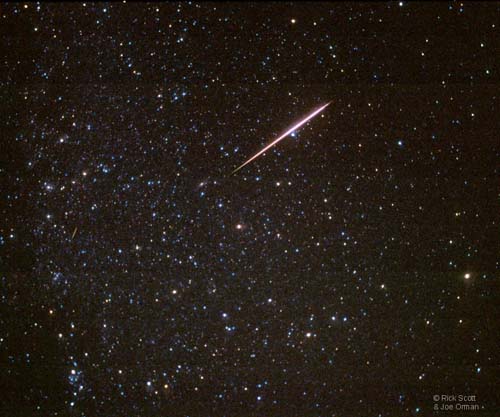The truth about the shooting star
In the darkness of the early morning of April 15, 1912, when the Titanic sank into the ice of the Atlantic Ocean, survivors saw a series of light trails in the sky that they believed to be souls of loved ones lying down in the sea, now heading to heaven.
According to Kevin Luhman, what they witnessed could be the pinnacle of the Lyriad meteor shower, an event that takes place annually between mid-April and the end of April.
Although oral stories of many cultures suggest that supernovae are a rare event, Luhman - assistant astronomer and celestial physics at Penn State - said 'They are not rare at all, even even they are not. "
'From the beginning of civilizations, humanity has seen streaks of light that look like stars but move very quickly across the sky. They are essentially cosmic rocks - celestial bodies - visible because of the heat generated when they enter the Earth's atmosphere at tremendous speeds . ' These pieces of ice and debris range in size from sand grains to a rock. Larger objects known as smaller asteroids are called meteorites - Luhman explains.

Image of a "fireball" of the Perseid meteor shower taken in 1997 (Photo: Rick Scott and Joe Orman)
Most celestial bodies are about the size of pebbles and are visible when they are about 40 to 75 miles from the ground.
The largest celestial bodies, often referred to as 'fireballs' explode and create powerful lights that can be observed during the day.
Even so, meteorites fall often so faint that they cannot be seen during the day. 'Meteors almost appear every time. The solar system is full of fragments. Every minute somewhere on Earth there is a stone or ice falling from the universe. '
A dark spot in the northern hemisphere promises to be the ideal location to watch meteor. The hours before the sun sets on a clear day is the most appropriate time since the Earth is slowly rotating around the axis, the orbital face may be subject to many 'cosmic hotels'. 'You should observe with the naked eye instead of using a telescope because the glass only shrinks part of the sky. If you look at the whole sky, you will find the meteor easier. '
Meteors fall like rain every year when Earth moves through the comet's tail - a sphere made of ice and stones also revolves around the Sun. 'They are named after the constellation that these meteorites come from.' Luhman also noted that the meteor shower Leonid and Perseid are the most famous and spectacular.
The Perseid meteor shower , which occurs in August every year and is named after the Greek hero Perseus, takes place when Earth moves into a thousand-year-old celestial debris cloud from Swift-Tuttle broom. The last time this comet was observed was in 1992 and with a diameter of 6 miles, this is the largest known object with repeating orbit near Earth.
According to Luhman, it is hard to forget the Leonid meteor shower in 1833. They are very bright and fall very fast, about 100,000 miles per hour, to the point where many people fear the end of the world. The storm is considered the birth of modern astronomy, marking the discovery of the constellation Leonid, which appeared on November 17 and caused fragments from Comet Tempel-Tuttle.

Leonid meteor shower - Image recorded at Fujimi Plateau - Nagano - Japan on November 18, 2001 (Photo: Shusaku Tago)
When the meteor phenomenon is now thoroughly explored, meteorites - ie the fragments of celestial bodies and asteroids exist after the penetration of our atmosphere and after the collision with the ground - is helping scientists learn about the origin of the solar system. Luhman said 'These rocks are basically remnants or rough ingredients from the solar system formed 4.5 billion years ago.'
Some meteorites even tell us about planets. 'If a comet crashed into Mars, it could throw some surface debris into space and after millions of years those pieces fell to the surface of the Earth.'
One of the 34 Martian rock pieces became famous in 1996 when NASA scientists announced it brought back early life evidence from 3.6 billion years ago. Newer studies that explain this formation are due to geological effects and the end of this scientific debate.
However, meteor rarely rarely leaves in our daily conversations. Movies, poetry still refer to these lights as a magical scene, a moment to think about wishes. Disney's theme song has come into the hearts of many generations ' When I dream before a star, my dream will become reality. '
- Don't joke, shooting just natural can kill others
- What will happen in the body when we shoot?
- Spot the star shooting 'water bullets' in the universe
- The truth about why light is reduced by aliens
- Why does shooting cause loud noise?
- The scientists were skeptical of discovering Star Death
- Violence prevention device
- For the first time, a star has been discovered in a star
- The mysterious age of the mysterious star
- Interesting things you didn't know about the 25,800 year old Northern star
- Witness the giant star's death
- The essence of the North Star
 Van Allen's belt and evidence that the Apollo 11 mission to the Moon was myth
Van Allen's belt and evidence that the Apollo 11 mission to the Moon was myth The levels of civilization in the universe (Kardashev scale)
The levels of civilization in the universe (Kardashev scale) Today Mars, the sun and the Earth are aligned
Today Mars, the sun and the Earth are aligned The Amazon owner announced a secret plan to build a space base for thousands of people
The Amazon owner announced a secret plan to build a space base for thousands of people